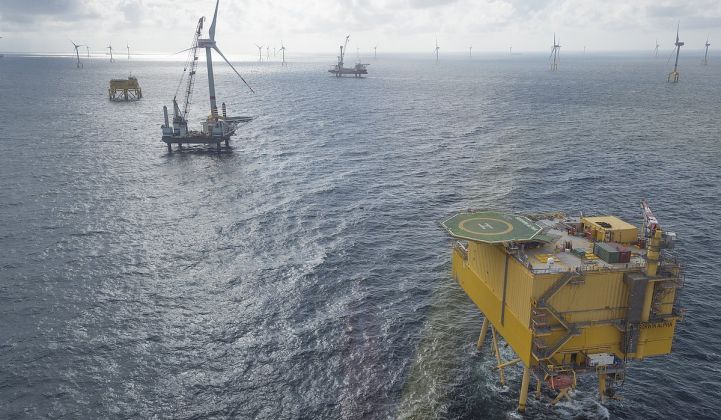The growing mismatch between Germany’s renewables capacity and the strength of its electricity network is leading to curtailment, crazy pricing and challenges for neighboring nations.
Although Germany is generating record amounts of clean energy in the north, its grid is too weak to transport all the power down to load centers in the south — a longstanding challenge for the country that is only getting worse.
One of the most visible effects of this renewable energy saturation on the German grid is negative wholesale electricity prices, times when consumers are effectively being paid to use excess power.
As favorable weather conditions pushed renewable energy up to almost 43 percent of the power supply mix in 2019, “there was an increase in the number of hours with negative prices due to high generation from renewables,” according to Agora Energiewende, a German think tank.
Spillover into other markets
At the same time, growth in German offshore wind installations is creating problems for Germany’s neighbors.
TenneT, the transmission system operator that serves the Netherlands and part of Germany, brought a record 20.2 terawatt-hours of energy onshore in 2019, or enough to power more than 6 million households. But because of a lack of adequate grid infrastructure, not all of it ends up going to German customers. Instead, experts said peaks in offshore generation had spilled over to Denmark, Poland, the Netherlands and beyond.
“This is not particularly desirable,” said Tom Andrews, a senior analyst at London, U.K.-based Cornwall Insight.
In January, TenneT said its 12 German North Sea offshore grid connections were already carrying more than 7 gigawatts of power, exceeding the federal government’s 2020 target of 6.5 gigawatts.
To prevent neighboring grids from being overwhelmed, Germany is installing phase-shifters on interconnectors, allowing for the blocking of loads at times. Phase-shifting transformers are hardly an elegant solution to Germany’s grid capacity problems — but then neither are some of the other options on the table.
The simplest option is to curtail renewable energy output. But the latest available figures show that curtailment of German wind has actually fallen in real terms.
German regulator the Federal Network Agency or Bundesnetzagentur said around 1.6 percent of renewable energy destined for the grid in the second and third quarters of last year was curtailed. This was roughly the same as the level seen in the second and third quarters of 2018, even though wind generation had risen by around 16 percent year-on-year in the third quarter of 2019.
Paying foreign wind farms to shut down?
The Bundesnetzagentur’s figures do not include instances where Germany paid foreign wind farms to shut down and allow its electricity to be exported.
This happened to Danish wind projects in 2015 as part of the integration of reserve and balancing services across international markets, said Andrews. “It doesn’t appear that there are any incidents of this recently,” he added.
However, other observers are unconvinced. An analysis by Danish energy consultant Paul-Frederik Bach shows 1.2 terawatt-hours of curtailment taking place in the western part of Denmark during 2018, equivalent to 5.7 percent of all electricity consumption in the region.
“If you look at the western part of Denmark, where we have a lot of wind power, people make the observation that when we have a lot of wind, all these wind turbines are not running," Bach told GTM. "They ask: ‘How is that?’ The reason is that Germany pays them to stop."
“It’s a booming business. Germany needs to export electricity north.”
The solution: Transmission? Or green hydrogen production?
None of this would be needed, said Bach, if Germany had the grid capacity to export all its northern wind energy production to its industrial heartland in the south. The federal government is well aware of this and is working to push through grid-strengthening measures.
But progress is hampered by local community resistance. “A lot of the lines will have to be underground,” explained Andrews. “This takes a lot longer, costs a lot more and potentially causes a lot more environmental damage than pylons.”
Another option would be to introduce different electricity price areas across the country. Having cheaper electricity in the north might encourage large power users to set up shop closer to where offshore wind is generated, Bach said.
Yet while electricity price areas are a common feature of Nordic energy markets, in Germany the idea of citizens in one place paying less for power than citizens in another is a political anathema, Bach said.
One final way to deal with Germany’s energy conundrum would be to find a way of mopping up excess power in the north.
“There are plans to consume excess renewable power by producing green hydrogen, which can be shipped via gas networks or stored for generation later," Andrews said. "We’re expecting a raft of announcements soon which will introduce subsidies for early movers on green hydrogen.”
Even with a big chunk of government money, though, it will take time for green hydrogen plants to flourish in the north of Germany. Until then, Germany’s neighbors will just have to put up with the country’s unruly energy antics.




